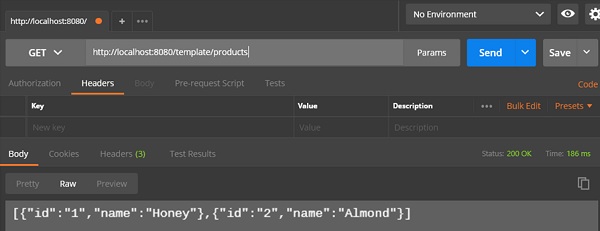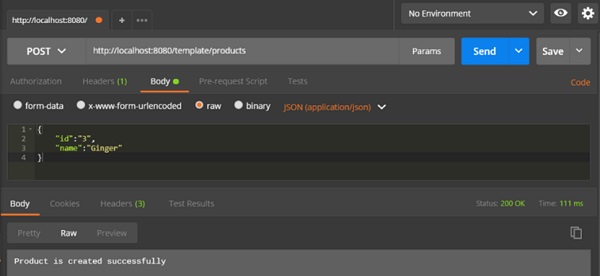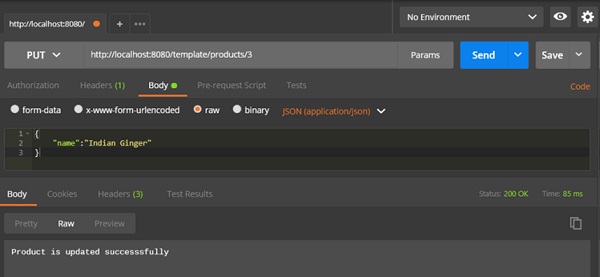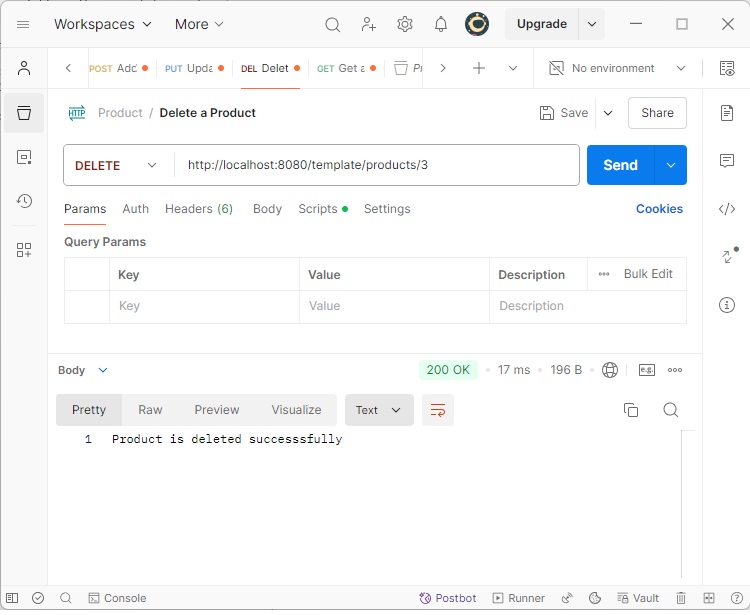Rest Templateは、RESTfulなWebサービスを消費するアプリケーションを作成するために使用されます。 exchange()メソッドを使って、すべてのHTTPメソッドのWebサービスを消費することができます。 以下に示すコードは、Rest Templateオブジェクトを自動配線するためのRest Template用のBeanを作成する方法を示しています。
package com.tutorialspoint.demo;import org.springframework.boot.SpringApplication;import org.springframework.boot.autoconfigure.SpringBootApplication;import org.springframework.context.annotation.Bean;import org.springframework.web.client.RestTemplate;@SpringBootApplicationpublic class DemoApplication { public static void main(String args) { SpringApplication.run(DemoApplication.class, args); } @Bean public RestTemplate getRestTemplate() { return new RestTemplate(); }}
GET
RestTemplate – exchange()メソッドを使用してGET APIをコンシュームします。 exchange()メソッド
このURL http://localhost:8080/productsが以下のJSONを返すと仮定して、以下のコードでRest Templateを使用してこのAPIレスポンスを消費することにします –
APIを消費するためには、以下の点に従わなければなりません –
- Rest Template Objectを自動化します。
- HttpHeadersを使用してリクエストヘッダーを設定する。
- HttpEntityを使用してリクエストオブジェクトをラップする。
- Exchange()メソッドにURL、HttpMethod、Return Typeを提供する。
@RestControllerpublic class ConsumeWebService { @Autowired RestTemplate restTemplate; @RequestMapping(value = "/template/products") public String getProductList() { HttpHeaders headers = new HttpHeaders(); headers.setAccept(Arrays.asList(MediaType.APPLICATION_JSON)); HttpEntity <String> entity = new HttpEntity<String>(headers); return restTemplate.exchange(" http://localhost:8080/products", HttpMethod.GET, entity, String.class).getBody(); }}
POST
Consuming POST API by using RestTemplate – exchange() method
このURL が以下のようなレスポンスを返すと仮定し、Rest Templateを使用してこのAPIレスポンスを消費します。
以下のコードがリクエストボディです –
{ "id":"3", "name":"Ginger"}
以下のコードがレスポンスボディです –
APIを利用するためには、以下のポイントを押さえる必要があります –
-
Rest Template Objectを自動化します。
-
HttpHeadersを使用して、リクエストヘッダーを設定する。
-
HttpEntityを使用して、リクエストオブジェクトをラップする。
-
HttpEntity を使用して、リクエスト オブジェクトをラップします。
-
exchange() メソッドの URL、HttpMethod、および Return Type を指定します。
@RestControllerpublic class ConsumeWebService { @Autowired RestTemplate restTemplate; @RequestMapping(value = "/template/products", method = RequestMethod.POST) public String createProducts(@RequestBody Product product) { HttpHeaders headers = new HttpHeaders(); headers.setAccept(Arrays.asList(MediaType.APPLICATION_JSON)); HttpEntity<Product> entity = new HttpEntity<Product>(product,headers); return restTemplate.exchange( "http://localhost:8080/products", HttpMethod.POST, entity, String.class).getBody(); }}
PUT
Consuming PUT API by using RestTemplate – exchange() method
このURL http://localhost:8080/products/3が以下のようなレスポンスを返すと仮定し、Rest Templateを使用してこのAPIレスポンスをコンシュームすることにします。
以下のコードがリクエストボディです –
{ "name":"Indian Ginger"}
以下のコードがレスポンスボディです –
Product is updated successfully
APIをコンシュームするためには、以下のポイントに従わなければなりません –
-
Rest Template Objectをオートワイヤードにします。
-
HttpHeadersを使用して、リクエストヘッダーを設定する。
-
HttpEntityを使用して、リクエストオブジェクトをラップする。
-
HttpEntity を使用して、リクエスト オブジェクトをラップします。
-
exchange() メソッドの URL、HttpMethod、および Return Type を提供します。
@RestControllerpublic class ConsumeWebService { @Autowired RestTemplate restTemplate; @RequestMapping(value = "/template/products/{id}", method = RequestMethod.PUT) public String updateProduct(@PathVariable("id") String id, @RequestBody Product product) { HttpHeaders headers = new HttpHeaders(); headers.setAccept(Arrays.asList(MediaType.APPLICATION_JSON)); HttpEntity<Product> entity = new HttpEntity<Product>(product,headers); return restTemplate.exchange( "http://localhost:8080/products/"+id, HttpMethod.PUT, entity, String.class).getBody(); }}
DELETE
RestTemplate – exchange()メソッドを使用してDELETE APIを消費する
このURL http://localhost:8080/products/3が以下のようなレスポンスを返すと仮定し、Rest Templateを使用してこのAPIレスポンスを消費することにします。
以下のコードはレスポンスボディです –
Product is deleted successfully
APIを消費するためには、以下のポイントに従わなければなりません –
-
Rest Template Objectを自動化します。
-
HttpHeadersを使用して、リクエストヘッダーを設定する。
-
HttpEntityを使用して、リクエストオブジェクトをラップする。
-
exchange()メソッドに、URL、HttpMethod、Return Typeを提供する。
@RestControllerpublic class ConsumeWebService { @Autowired RestTemplate restTemplate; @RequestMapping(value = "/template/products/{id}", method = RequestMethod.DELETE) public String deleteProduct(@PathVariable("id") String id) { HttpHeaders headers = new HttpHeaders(); headers.setAccept(Arrays.asList(MediaType.APPLICATION_JSON)); HttpEntity<Product> entity = new HttpEntity<Product>(headers); return restTemplate.exchange( "http://localhost:8080/products/"+id, HttpMethod.DELETE, entity, String.class).getBody(); }}
Rest Template Controllerクラスファイルの詳細は以下の通りです –
package com.tutorialspoint.demo.controller;import java.util.Arrays;import org.springframework.beans.factory.annotation.Autowired;import org.springframework.http.HttpEntity;import org.springframework.http.HttpHeaders;import org.springframework.http.HttpMethod;import org.springframework.http.MediaType;import org.springframework.web.bind.annotation.PathVariable;import org.springframework.web.bind.annotation.RequestBody;import org.springframework.web.bind.annotation.RequestMapping;import org.springframework.web.bind.annotation.RequestMethod;import org.springframework.web.bind.annotation.RestController;import org.springframework.web.client.RestTemplate;import com.tutorialspoint.demo.model.Product;@RestControllerpublic class ConsumeWebService { @Autowired RestTemplate restTemplate; @RequestMapping(value = "/template/products") public String getProductList() { HttpHeaders headers = new HttpHeaders(); headers.setAccept(Arrays.asList(MediaType.APPLICATION_JSON)); HttpEntity<String> entity = new HttpEntity<String>(headers); return restTemplate.exchange( "http://localhost:8080/products", HttpMethod.GET, entity, String.class).getBody(); } @RequestMapping(value = "/template/products", method = RequestMethod.POST) public String createProducts(@RequestBody Product product) { HttpHeaders headers = new HttpHeaders(); headers.setAccept(Arrays.asList(MediaType.APPLICATION_JSON)); HttpEntity<Product> entity = new HttpEntity<Product>(product,headers); return restTemplate.exchange( "http://localhost:8080/products", HttpMethod.POST, entity, String.class).getBody(); } @RequestMapping(value = "/template/products/{id}", method = RequestMethod.PUT) public String updateProduct(@PathVariable("id") String id, @RequestBody Product product) { HttpHeaders headers = new HttpHeaders(); headers.setAccept(Arrays.asList(MediaType.APPLICATION_JSON)); HttpEntity<Product> entity = new HttpEntity<Product>(product,headers); return restTemplate.exchange( "http://localhost:8080/products/"+id, HttpMethod.PUT, entity, String.class).getBody(); } @RequestMapping(value = "/template/products/{id}", method = RequestMethod.DELETE) public String deleteProduct(@PathVariable("id") String id) { HttpHeaders headers = new HttpHeaders(); headers.setAccept(Arrays.asList(MediaType.APPLICATION_JSON)); HttpEntity<Product> entity = new HttpEntity<Product>(headers); return restTemplate.exchange( "http://localhost:8080/products/"+id, HttpMethod.DELETE, entity, String.class).getBody(); }}
Spring Boot Application Class – DemoApplication.javaのコードは以下の通りです。javaは以下の通りです –
package com.tutorialspoint.demo;import org.springframework.boot.SpringApplication;import org.springframework.boot.autoconfigure.SpringBootApplication;@SpringBootApplicationpublic class DemoApplication { public static void main(String args) { SpringApplication.run(DemoApplication.class, args); }}
Mavenビルド用のコード – pom.xmlは以下の通りです –
<?xml version = "1.0" encoding = "UTF-8"?><project xmlns = "http://maven.apache.org/POM/4.0.0" xmlns:xsi = "http://www.w3.org/2001/XMLSchema-instance" xsi:schemaLocation = "http://maven.apache.org/POM/4.0.0 http://maven.apache.org/xsd/maven-4.0.0.xsd"> <modelVersion>4.0.0</modelVersion> <groupId>com.tutorialspoint</groupId> <artifactId>demo</artifactId> <version>0.0.1-SNAPSHOT</version> <packaging>jar</packaging> <name>demo</name> <description>Demo project for Spring Boot</description> <parent> <groupId>org.springframework.boot</groupId> <artifactId>spring-boot-starter-parent</artifactId> <version>1.5.8.RELEASE</version> <relativePath/> </parent> <properties> <project.build.sourceEncoding>UTF-8</project.build.sourceEncoding> <project.reporting.outputEncoding>UTF-8</project.reporting.outputEncoding> <java.version>1.8</java.version> </properties> <dependencies> <dependency> <groupId>org.springframework.boot</groupId> <artifactId>spring-boot-starter-web</artifactId> </dependency> <dependency> <groupId>org.springframework.boot</groupId> <artifactId>spring-boot-starter-test</artifactId> <scope>test</scope> </dependency> </dependencies> <build> <plugins> <plugin> <groupId>org.springframework.boot</groupId> <artifactId>spring-boot-maven-plugin</artifactId> </plugin> </plugins> </build> </project>
Gradleビルド用のコード – build.gradleのコードは以下の通りです –
buildscript { ext { springBootVersion = '1.5.8.RELEASE' } repositories { mavenCentral() } dependencies { classpath("org.springframework.boot:spring-boot-gradle-plugin:${springBootVersion}") }}apply plugin: 'java'apply plugin: 'eclipse'apply plugin: 'org.springframework.boot'group = 'com.tutorialspoint'version = '0.0.1-SNAPSHOT'sourceCompatibility = 1.8repositories { mavenCentral()}dependencies { compile('org.springframework.boot:spring-boot-starter-web') testCompile('org.springframework.boot:spring-boot-starter-test')}
以下のMavenまたはGradleのコマンドを使用して、実行可能なJARファイルを作成し、Spring Bootアプリケーションを実行することができます –
Mavenの場合、以下のコマンドを使用できます。
Mavenの場合、以下のコマンドを使用できます –
mvn clean install
「BUILD SUCCESS」の後、ターゲットディレクトリの下にJARファイルを見つけることができます。
Gradleの場合は、以下のコマンドを使用できます –
gradle clean build
「BUILD SUCCESSFUL」の後、build/libsディレクトリの下にJARファイルを見つけることができます。
ここで、次のコマンドを使ってJARファイルを実行します –
java –jar <JARFILE>
これで、Tomcatのポート8080でアプリケーションが起動しました。

さて、POSTMANアプリケーションで以下のURLをヒットすると、出力を見ることができます。
Rest Templateによる製品の取得 – http://localhost:8080/template/products

作成します。 Product POST – http://localhost:8080/template/products

Update Product PUT – http://localhost:8080/template/products/3

商品の削除 – http://localhost:8080/template/products/3
